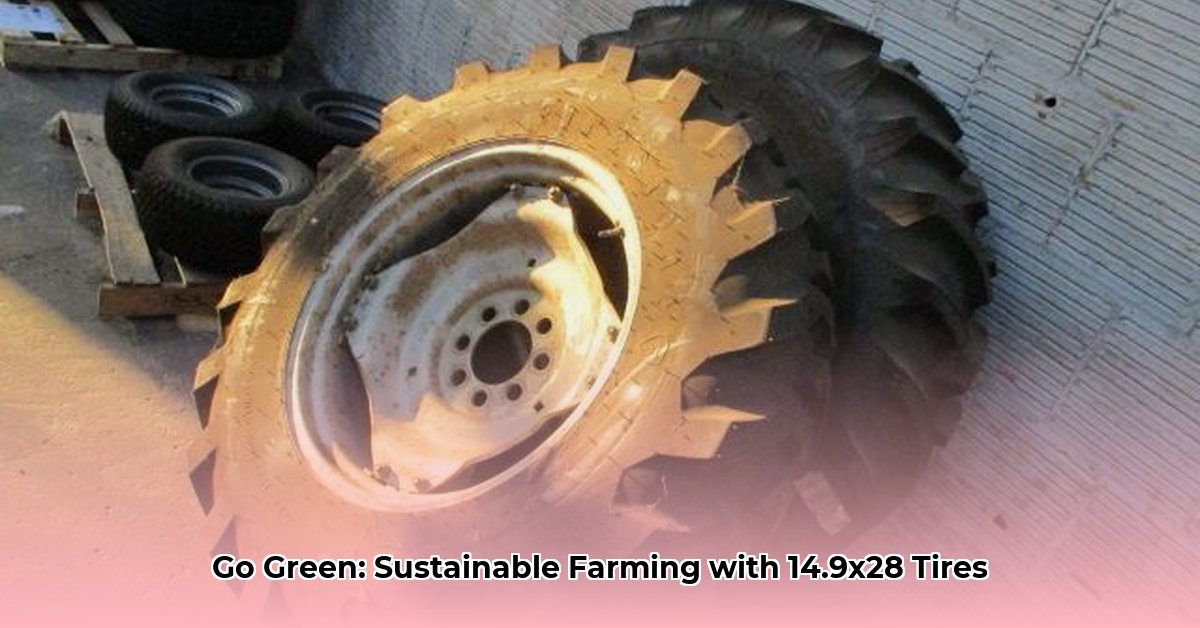
Choosing the right tires for your tractor is a crucial decision impacting fuel efficiency, soil health, and operational costs. This guide focuses on the popular 14.9 x 28 tire size, exploring its role in sustainable agricultural practices. We'll examine tire specifications, soil compaction, fuel efficiency, lifespan, and selection criteria to help you make informed decisions. For more on tire maintenance, check out this helpful resource on foam-filling options.
Tire Specifications and Performance: Understanding the 14.9 x 28
The 14.9 x 28 designation indicates a tire 14.9 inches wide and having a 28-inch diameter. This size offers a balance between flotation (reducing soil compaction) and traction. The tire's construction, typically radial, enhances stability and wear resistance. Radial construction means the tire plies run radially from the center to the bead providing better stability and wear resistance compared to bias-ply tires. The deep tread pattern provides excellent grip, crucial for maneuvering in diverse soil conditions. However, deeper treads can slightly increase rolling resistance compared to shallower treads, which impacts fuel economy. This trade-off, however, is often justified by the improved traction and resulting reduction in passes over the field.
Don't underestimate the importance of tire construction. A robust tire structure is essential for withstanding the stresses of fieldwork, heavy loads, and varying terrains. The materials used in the tire, and how they're layered, all contribute to overall durability and performance. A quality tire design mitigates potential damage from rocks or debris commonly found in fields.
Impact on Soil Compaction: Protecting Soil Health
Soil compaction significantly reduces crop yields. Compacted soil resists water infiltration hindering root growth and overall plant health. The 14.9 x 28 tire's larger footprint distributes weight more effectively than smaller tires, reducing ground pressure and thus minimizing compaction. This translates to healthier soil, improved water penetration, and better aeration, leading to increased crop yields and long-term soil quality. Isn't maintaining soil health a cornerstone of sustainable agriculture?
Lowering tire pressure further reduces compaction. However, excessively low pressure increases the risk of tire damage, such as sidewall flexing or blowouts. Finding the optimal pressure balance is crucial. Advanced monitoring systems such as tire pressure monitoring systems (TPMS) can help you maintain ideal inflation and optimize performance while protecting your investment.
Fuel Efficiency and Operational Costs: Optimizing Resource Use
While larger tires like the 14.9 x 28 might exhibit slightly higher rolling resistance than smaller ones, leading to marginally increased fuel consumption, this often gets offset by factors like reduced compaction. Reduced compaction means fewer passes are required to complete field work, thus reducing fuel use and time required to complete field tasks. Proper inflation is critical; under-inflation significantly increases rolling resistance, wasting fuel and increasing wear. Over-inflation, conversely, can also increase compaction and premature tire wear.
Maintaining proper inflation and regular tire maintenance is paramount to ensuring optimal fuel efficiency. A well-maintained tire not only aids fuel efficiency but extends the tire's lifespan, resulting in cost savings over the tire's operational lifetime. Consider that a well-maintained tire needs replacement far less frequently minimizing waste and disposal costs associated with early tire failure.
Tire Lifespan and Sustainability: Maximizing Investment and Minimizing Waste
The lifespan of a 14.9 x 28 tire depends on various factors, including soil conditions, operating practices, and maintenance. Proper inflation significantly influences lifespan; consistent monitoring and adjustments are key. Regular inspections for cuts, punctures, or uneven wear are crucial for detecting problems early. Addressing these issues promptly prevents further damage and extends the tire’s operational life.
Tire retreading, the process of adding new tread to a worn tire, offers a sustainable alternative to purchasing new tires, significantly reducing waste. Retreading extends the tire's useful life, improving cost-effectiveness and reducing the environmental impact of tire disposal. This is a significant benefit for farmers seeking environmentally friendly and cost effective long-term solutions.
Choosing the Right Tire for Your Operation: A Decision-Making Framework
Selecting the ideal tire involves considering several factors. Soil type is paramount; clay soils may need different tire pressures and tread patterns than sandy or loamy soils. Your farming practices (no-till, conventional tillage) also influence the tire requirements. Consider your budget, balancing initial cost with long-term cost savings from better fuel efficiency and extended tire lifespan. The climate also plays a role, as extreme temperatures can impact tire performance and longevity. Ultimately, the best tire is the one that optimally balances your specific needs and budget.
Conclusion: Sustainable Choices for a Sustainable Future
The 14.9 x 28 tire, when properly utilized and maintained, represents a solid choice for sustainable agricultural practices. Understanding its specifications, impact on soil compaction, and fuel efficiency is crucial. Combining this knowledge with a thoughtful evaluation of your farming operation will lead to better decision-making, resulting in optimized cost-effectiveness and minimized environmental impact. Investing in knowledge and adopting sustainable practices today ensures a profitable and environmentally responsible future.